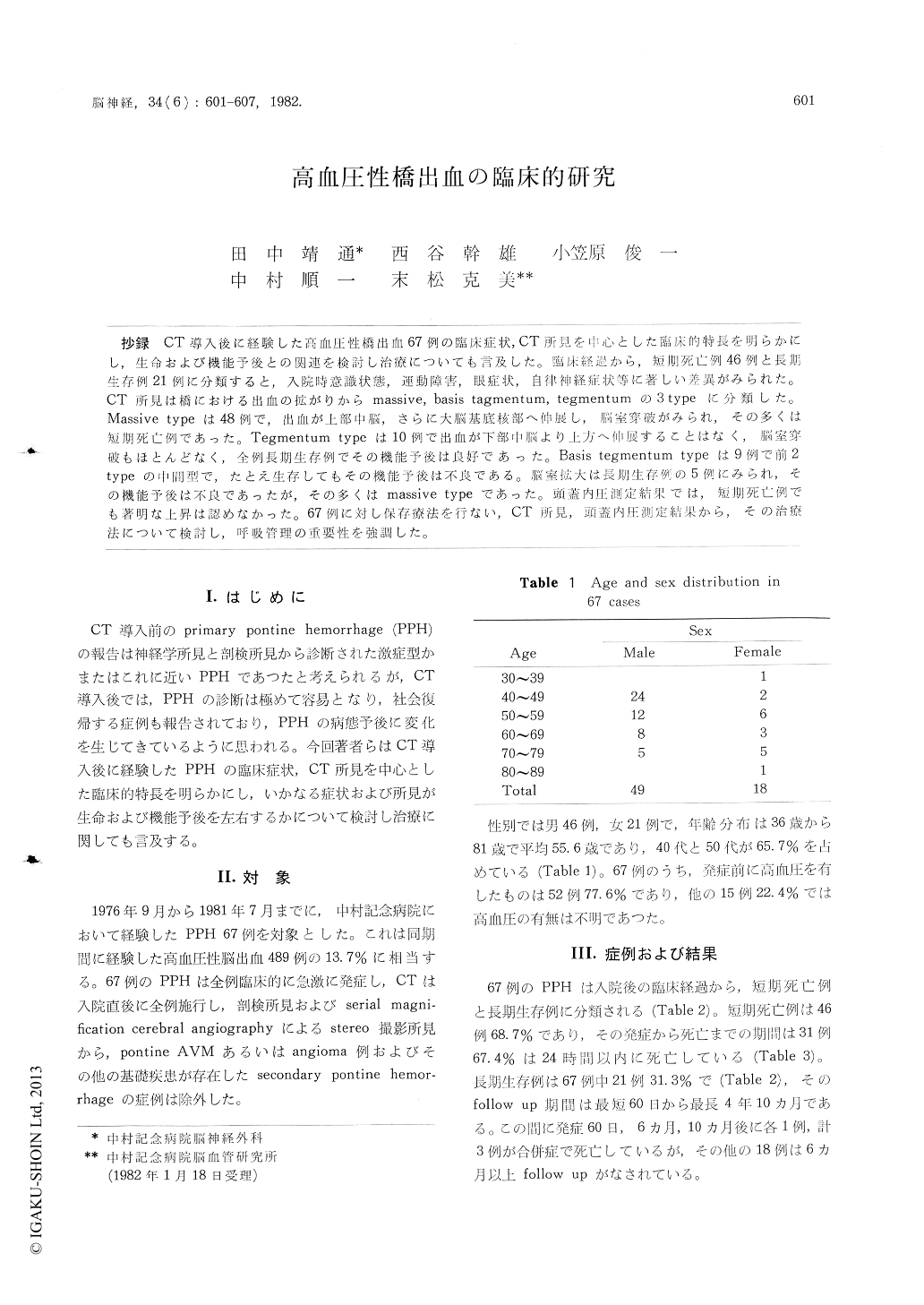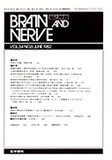Japanese
English
- 有料閲覧
- Abstract 文献概要
- 1ページ目 Look Inside
抄録 CT導入後に経験した高血圧性橋出血67例の臨床症状,CT所見を中心とした臨床的特長を明らかにし,生命および機能予後との関連を検討し治療についても言及した。臨床経通から,短期死亡例46例と長期生存例21例に分類すると,入院時意識状態,運動障害,眼症状,自律神経症状等に著しい差異がみられた。CT所見は橋における出血の拡がりからmassive, basis tagmentum, tegmentumの3 typeに分類した。Massive typeは48例で,出血が上部中脳,さらに大脳基底核部へ伸展し,脳室穿破がみられ,その多くは短期死亡例であった。Tegmentum typeは10例で出血が下部中脳より上方へ伸展することはなく,脳室穿破もほとんどなく,全例長期生存例でその機能予後は良好であった。Basis tegmentum typeは9例で前2typeの中間型で,たとえ生存してもその機能予後は不良である。脳室拡大は長期生存例の5例にみられ,その機能予後は不良であったが,その多くはmassive typeであった。頭蓋内圧測定結果では,短期死亡例でも著明な上昇は認めなかった。67例に対し保存療法を行ない,CT所見,頭蓋内圧測定結果から,その治療法について検討し,呼吸管理の重要性を強調した。
We experienced a total of 67 cases of PPH during a period from September 1976 through July 1981.This series comprised 49 males and 18 females ranging in age from 36 to 81 years with an average age 55. 6 years. In all these cases conservative treatment measures were taken.
These patients are divided into 2 groups, as follow short-term and long-term survivors. Forty-six were short-term survivors, with 31 of them dying within 24 hours of onset. Long-term survivors accounted for 21.
By comparison of clinical symptomatology be-tween short-term and long-term survivors, striking differences were observed between the two groups of patients.
CT findings of PPH are roughly divided into 3 types massive, basis tegmentum and tegmentum. Massive type represents diffuse pontine hemorrhage, involving the midbrain and thalamus, with associ-ated ventricle rupture. In basis tegmentum type, pontine basis and tegmentum is the main site of hemorrhage. In tegmentum type, pontine tegmen-tum is the main site of hemorrhage, while in the pontine basis hemorrhage is absent or slight, if present. Each of basis tegmentum and tegmentum type are further divided into 2 subtypes, bilateral and unilateral, respectively.
In these types ventricle rupture by a hematoma and extension of hemorrhage to the upper portion of midbrain and thalamus are seldom seen. Of 48 patients with hemorrhage of massive type, 44 died. Nine patients were classified as basis tegmentum type. Of these 9, those without ventricle rupture and extension of hematoma to upper midbrain are all surviving. As for ADL of survivors, one patient each with bilateral subtype hemorrhage was rated as ADL IV and V ; of those with unilateral sub-type hemorrhage, 4 were rated as ADL III and another as ADL I. Ten patients presented with hemorrhage of tegmentum type ; these 10 patients are all alive and ADL were graded as I, II and III in 4, 2 and 4, respectively, of them.
In 8 cases in our series we could obtain serial measurements of intracranial pressure (ICP) by monitoring of ventricular pressure at the frontal horn of the lateral ventricle. It became thus ob-vious that PPH was unassociated with any con-spicuous rise in ICP even in short-term survivors while long-term survivors demonstrated no notice-able pressure rise.
Follow-up CT disclosed enlargement of the ven-tricles in only long-term survivors and a marked enlargement in 2 of them. The remainders showed a minimal degree of ventricular enlargement. In view of these findings we are of the opinion that in treating PPH one need not to perform drainage or a shunt operation for the control of ICP.
Our experiences with conservative treatment in 67 cases of PPH have led us to believe that respi-ratory care is the most important of all treatment measures currently available for the management of PPH.

Copyright © 1982, Igaku-Shoin Ltd. All rights reserved.


